Abstract
Mouse peritoneal macrophages activated by different immunomodulators (Mycobacterium bovis bacillus Calmette-Guérin or Propionibacterium acnes) destroy Naegleria fowleri amoebae by a contact-dependent process and by soluble cytolytic molecules secreted by macrophages in response to lipopolysaccharide. The goal of this study was to determine whether the arginine-dependent cytolytic mechanism which results in the production of nitric oxide from arginine by activated macrophages destroys the amoebae. Amoebicidal activity of activated macrophages was determined by coculturing macrophages with N. fowleri amoebae radiolabeled with 3H-uridine. The percent specific release of radiolabel was used as an index of cytolysis of the amoebae. The inhibitors NG-monomethyl-L-arginine and arginase were used to determine whether the arginine pathway was a major effector mechanism responsible for amoebicidal activity of activated macrophages. Both the arginine analog NG-monomethyl-L-arginine and arginase, which breaks down arginine, decreased macrophage amoebicidal activity. Addition of arginine to arginine-free medium restores amoebicidal activity to activated macrophage cultures. These results demonstrate that the arginine pathway is an important mechanism for the destruction of susceptible N. fowleri amoebae.
Full text
PDF
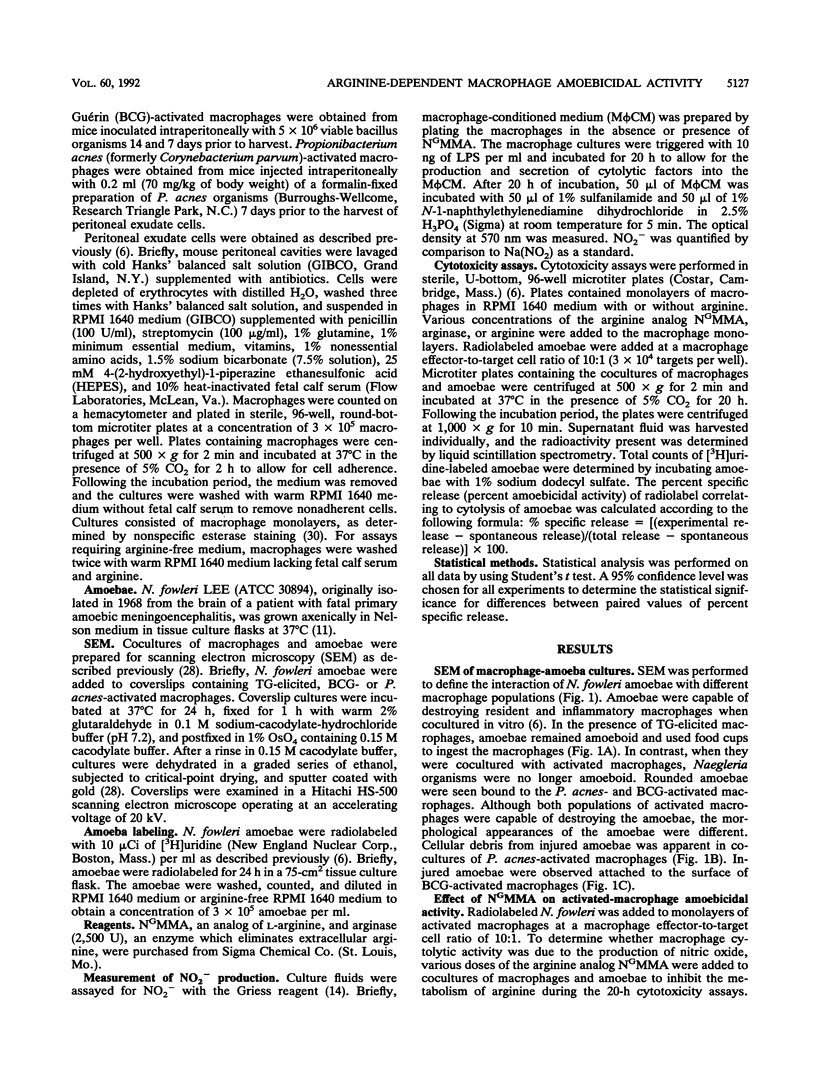
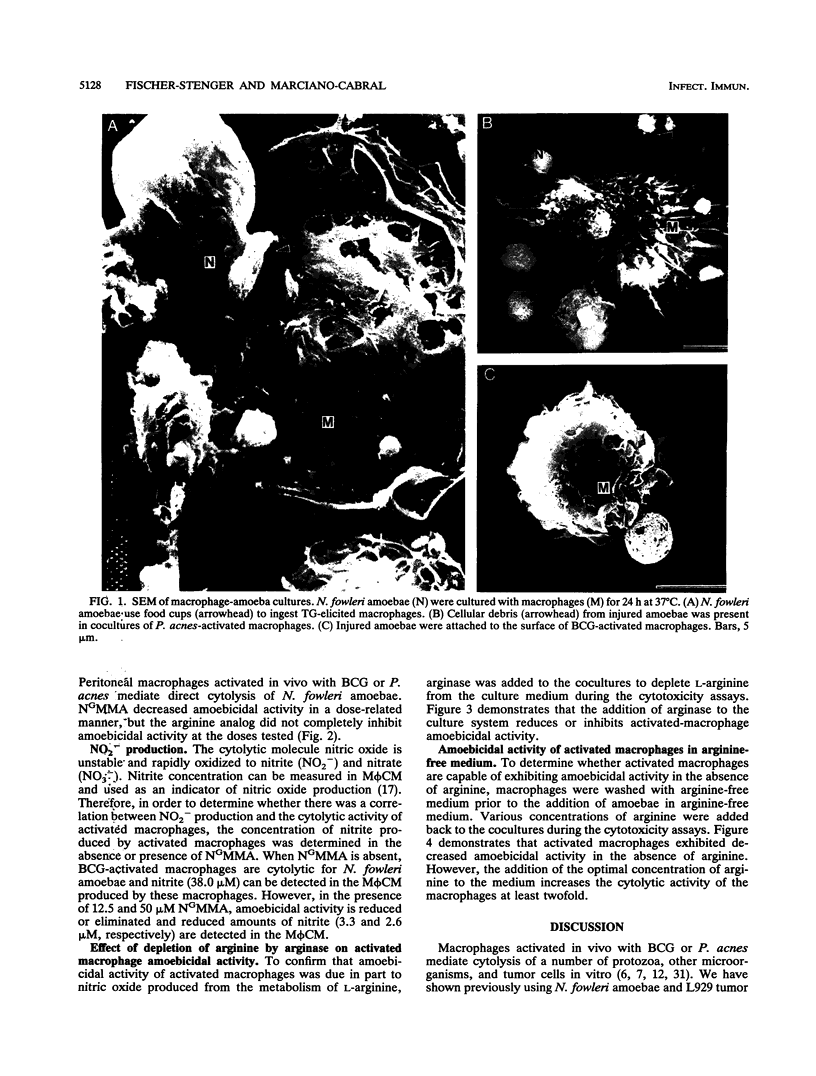
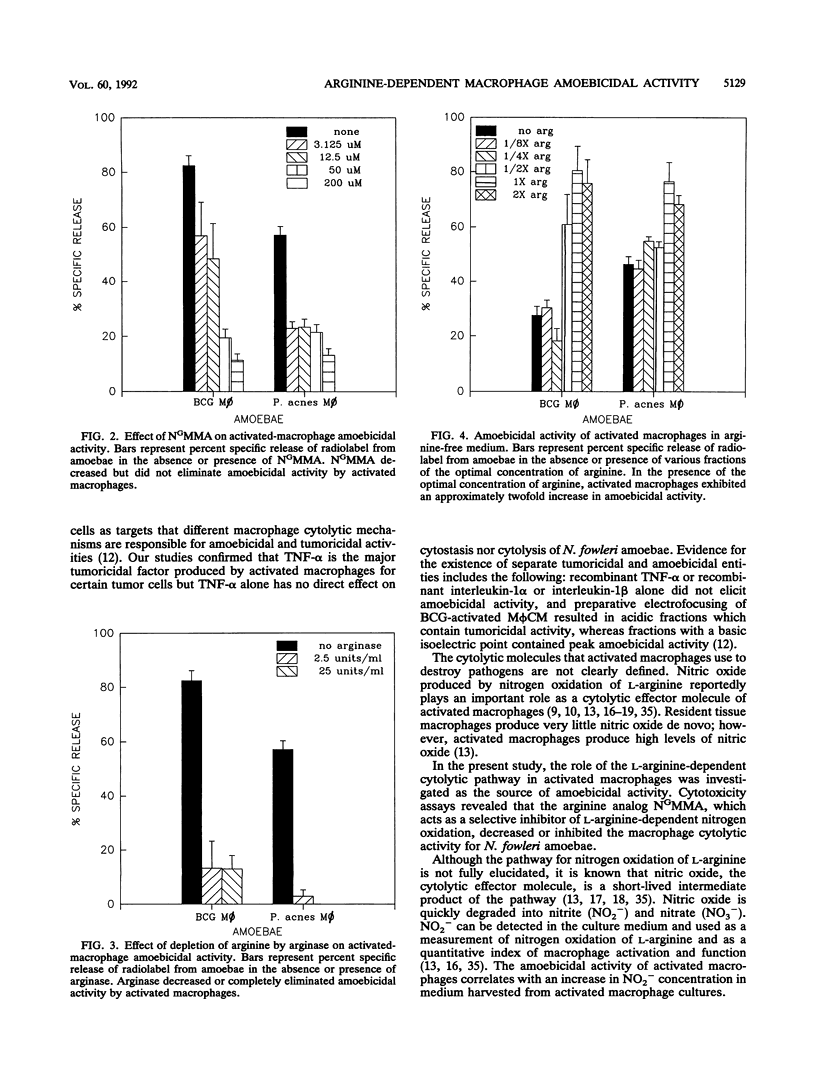
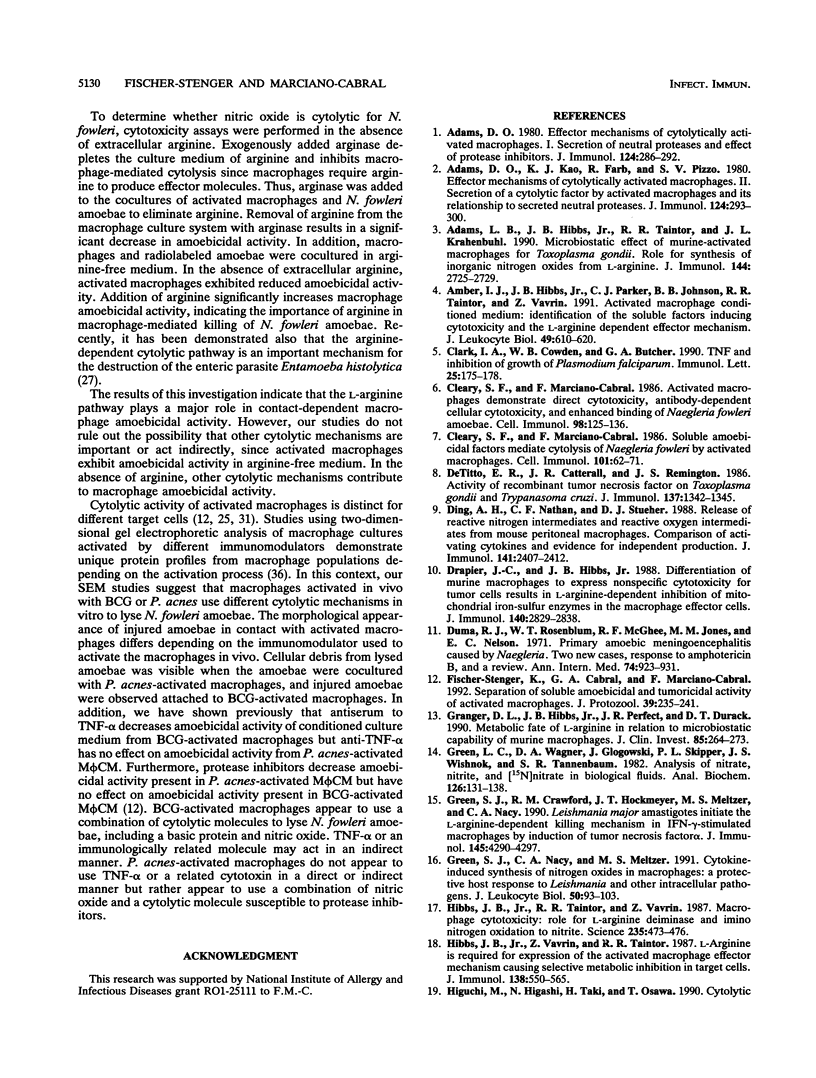
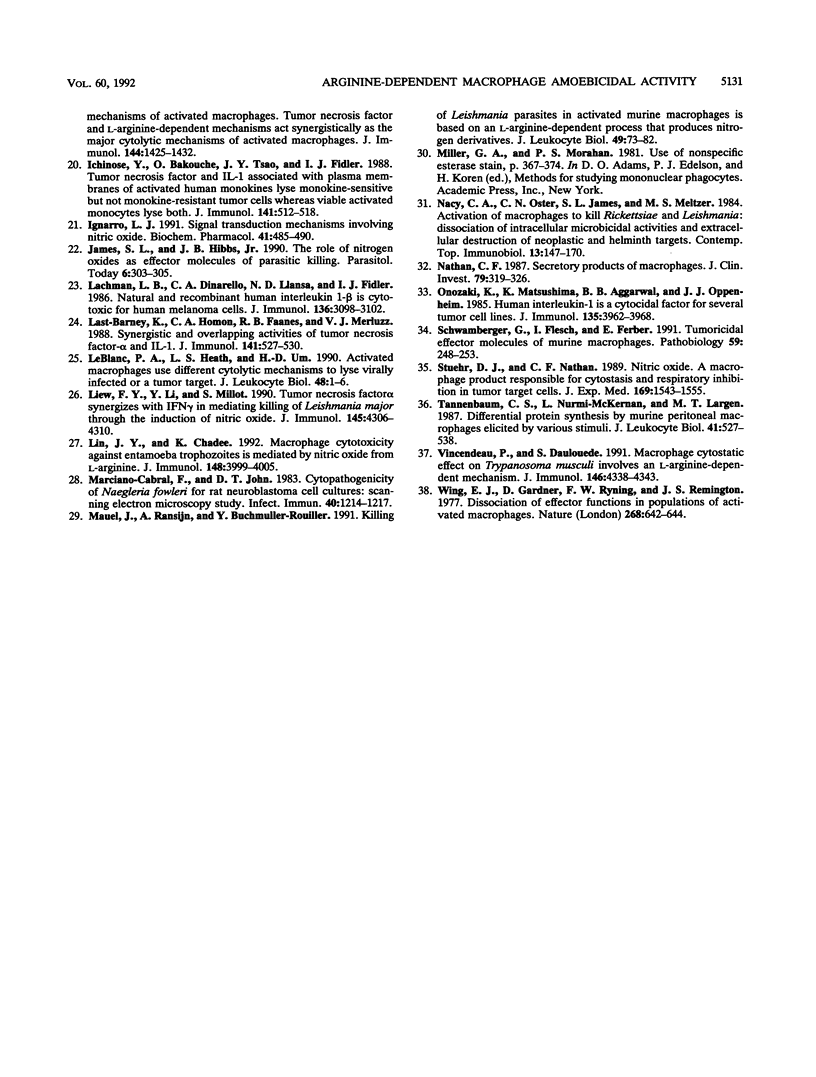
Images in this article
Selected References
These references are in PubMed. This may not be the complete list of references from this article.
- Adams D. O. Effector mechanisms of cytolytically activated macrophages. I. Secretion of neutral proteases and effect of protease inhibitors. J Immunol. 1980 Jan;124(1):286–292. [PubMed] [Google Scholar]
- Adams D. O., Kao K. J., Farb R., Pizzo S. V. Effector mechanisms of cytolytically activated macrophages. II. Secretion of a cytolytic factor by activated macrophages and its relationship to secreted neutral proteases. J Immunol. 1980 Jan;124(1):293–300. [PubMed] [Google Scholar]
- Adams L. B., Hibbs J. B., Jr, Taintor R. R., Krahenbuhl J. L. Microbiostatic effect of murine-activated macrophages for Toxoplasma gondii. Role for synthesis of inorganic nitrogen oxides from L-arginine. J Immunol. 1990 Apr 1;144(7):2725–2729. [PubMed] [Google Scholar]
- Amber I. J., Hibbs J. B., Jr, Parker C. J., Johnson B. B., Taintor R. R., Vavrin Z. Activated macrophage conditioned medium: identification of the soluble factors inducing cytotoxicity and the L-arginine dependent effector mechanism. J Leukoc Biol. 1991 Jun;49(6):610–620. doi: 10.1002/jlb.49.6.610. [DOI] [PubMed] [Google Scholar]
- Clark I. A., Cowden W. B., Butcher G. A. TNF and inhibition of growth of Plasmodium falciparum. Immunol Lett. 1990 Aug;25(1-3):175–178. doi: 10.1016/0165-2478(90)90111-3. [DOI] [PubMed] [Google Scholar]
- Cleary S. F., Marciano-Cabral F. Activated macrophages demonstrate direct cytotoxicity, antibody-dependent cellular cytotoxicity, and enhanced binding of Naegleria fowleri amoebae. Cell Immunol. 1986 Mar;98(1):125–136. doi: 10.1016/0008-8749(86)90273-x. [DOI] [PubMed] [Google Scholar]
- Cleary S. F., Marciano-Cabral F. Soluble amoebicidal factors mediate cytolysis of Naegleria fowleri by activated macrophages. Cell Immunol. 1986 Aug;101(1):62–71. doi: 10.1016/0008-8749(86)90186-3. [DOI] [PubMed] [Google Scholar]
- De Titto E. H., Catterall J. R., Remington J. S. Activity of recombinant tumor necrosis factor on Toxoplasma gondii and Trypanosoma cruzi. J Immunol. 1986 Aug 15;137(4):1342–1345. [PubMed] [Google Scholar]
- Ding A. H., Nathan C. F., Stuehr D. J. Release of reactive nitrogen intermediates and reactive oxygen intermediates from mouse peritoneal macrophages. Comparison of activating cytokines and evidence for independent production. J Immunol. 1988 Oct 1;141(7):2407–2412. [PubMed] [Google Scholar]
- Drapier J. C., Hibbs J. B., Jr Differentiation of murine macrophages to express nonspecific cytotoxicity for tumor cells results in L-arginine-dependent inhibition of mitochondrial iron-sulfur enzymes in the macrophage effector cells. J Immunol. 1988 Apr 15;140(8):2829–2838. [PubMed] [Google Scholar]
- Duma R. J., Rosenblum W. I., McGehee R. F., Jones M. M., Nelson E. C. Primary amoebic meningoencephalitis caused by Naegleria. Two new cases, response to amphotericin B, and a review. Ann Intern Med. 1971 Jun;74(6):923–931. doi: 10.7326/0003-4819-74-6-923. [DOI] [PubMed] [Google Scholar]
- Fischer-Stenger K., Cabral G. A., Marciano-Cabral F. Separation of soluble amoebicidal and tumoricidal activity of activated macrophages. J Protozool. 1992 Jan-Feb;39(1):235–241. doi: 10.1111/j.1550-7408.1992.tb01307.x. [DOI] [PubMed] [Google Scholar]
- Granger D. L., Hibbs J. B., Jr, Perfect J. R., Durack D. T. Metabolic fate of L-arginine in relation to microbiostatic capability of murine macrophages. J Clin Invest. 1990 Jan;85(1):264–273. doi: 10.1172/JCI114422. [DOI] [PMC free article] [PubMed] [Google Scholar]
- Green L. C., Wagner D. A., Glogowski J., Skipper P. L., Wishnok J. S., Tannenbaum S. R. Analysis of nitrate, nitrite, and [15N]nitrate in biological fluids. Anal Biochem. 1982 Oct;126(1):131–138. doi: 10.1016/0003-2697(82)90118-x. [DOI] [PubMed] [Google Scholar]
- Green S. J., Crawford R. M., Hockmeyer J. T., Meltzer M. S., Nacy C. A. Leishmania major amastigotes initiate the L-arginine-dependent killing mechanism in IFN-gamma-stimulated macrophages by induction of tumor necrosis factor-alpha. J Immunol. 1990 Dec 15;145(12):4290–4297. [PubMed] [Google Scholar]
- Green S. J., Nacy C. A., Meltzer M. S. Cytokine-induced synthesis of nitrogen oxides in macrophages: a protective host response to Leishmania and other intracellular pathogens. J Leukoc Biol. 1991 Jul;50(1):93–103. doi: 10.1002/jlb.50.1.93. [DOI] [PubMed] [Google Scholar]
- Hibbs J. B., Jr, Taintor R. R., Vavrin Z. Macrophage cytotoxicity: role for L-arginine deiminase and imino nitrogen oxidation to nitrite. Science. 1987 Jan 23;235(4787):473–476. doi: 10.1126/science.2432665. [DOI] [PubMed] [Google Scholar]
- Hibbs J. B., Jr, Vavrin Z., Taintor R. R. L-arginine is required for expression of the activated macrophage effector mechanism causing selective metabolic inhibition in target cells. J Immunol. 1987 Jan 15;138(2):550–565. [PubMed] [Google Scholar]
- Higuchi M., Higashi N., Taki H., Osawa T. Cytolytic mechanisms of activated macrophages. Tumor necrosis factor and L-arginine-dependent mechanisms act synergistically as the major cytolytic mechanisms of activated macrophages. J Immunol. 1990 Feb 15;144(4):1425–1431. [PubMed] [Google Scholar]
- Ichinose Y., Bakouche O., Tsao J. Y., Fidler I. J. Tumor necrosis factor and IL-1 associated with plasma membranes of activated human monocytes lyse monokine-sensitive but not monokine-resistant tumor cells whereas viable activated monocytes lyse both. J Immunol. 1988 Jul 15;141(2):512–518. [PubMed] [Google Scholar]
- Ignarro L. J. Signal transduction mechanisms involving nitric oxide. Biochem Pharmacol. 1991 Feb 15;41(4):485–490. doi: 10.1016/0006-2952(91)90618-f. [DOI] [PubMed] [Google Scholar]
- James S. L., Hibbs J. B., Jr The role of nitrogen oxides as effector molecules of parasite killing. Parasitol Today. 1990 Sep;6(9):303–305. doi: 10.1016/0169-4758(90)90261-2. [DOI] [PubMed] [Google Scholar]
- Lachman L. B., Dinarello C. A., Llansa N. D., Fidler I. J. Natural and recombinant human interleukin 1-beta is cytotoxic for human melanoma cells. J Immunol. 1986 Apr 15;136(8):3098–3102. [PubMed] [Google Scholar]
- Last-Barney K., Homon C. A., Faanes R. B., Merluzzi V. J. Synergistic and overlapping activities of tumor necrosis factor-alpha and IL-1. J Immunol. 1988 Jul 15;141(2):527–530. [PubMed] [Google Scholar]
- LeBlanc P. A., Heath L. S., Um H. D. Activated macrophages use different cytolytic mechanisms to lyse a virally infected or a tumor target. J Leukoc Biol. 1990 Jul;48(1):1–6. doi: 10.1002/jlb.48.1.1. [DOI] [PubMed] [Google Scholar]
- Liew F. Y., Li Y., Millott S. Tumor necrosis factor-alpha synergizes with IFN-gamma in mediating killing of Leishmania major through the induction of nitric oxide. J Immunol. 1990 Dec 15;145(12):4306–4310. [PubMed] [Google Scholar]
- Lin J. Y., Chadee K. Macrophage cytotoxicity against Entamoeba histolytica trophozoites is mediated by nitric oxide from L-arginine. J Immunol. 1992 Jun 15;148(12):3999–4005. [PubMed] [Google Scholar]
- Marciano-Cabral F., John D. T. Cytopathogenicity of Naegleria fowleri for rat neuroblastoma cell cultures: scanning electron microscopy study. Infect Immun. 1983 Jun;40(3):1214–1217. doi: 10.1128/iai.40.3.1214-1217.1983. [DOI] [PMC free article] [PubMed] [Google Scholar]
- Mauël J., Ransijn A., Buchmüller-Rouiller Y. Killing of Leishmania parasites in activated murine macrophages is based on an L-arginine-dependent process that produces nitrogen derivatives. J Leukoc Biol. 1991 Jan;49(1):73–82. doi: 10.1002/jlb.49.1.73. [DOI] [PubMed] [Google Scholar]
- Nacy C. A., Oster C. N., James S. L., Meltzer M. S. Activation of macrophages to kill rickettsiae and Leishmania: dissociation of intracellular microbicidal activities and extracellular destruction of neoplastic and helminth targets. Contemp Top Immunobiol. 1984;13:147–170. doi: 10.1007/978-1-4757-1445-6_8. [DOI] [PubMed] [Google Scholar]
- Nathan C. F. Secretory products of macrophages. J Clin Invest. 1987 Feb;79(2):319–326. doi: 10.1172/JCI112815. [DOI] [PMC free article] [PubMed] [Google Scholar]
- Onozaki K., Matsushima K., Aggarwal B. B., Oppenheim J. J. Human interleukin 1 is a cytocidal factor for several tumor cell lines. J Immunol. 1985 Dec;135(6):3962–3968. [PubMed] [Google Scholar]
- Schwamberger G., Flesch I., Ferber E. Tumoricidal effector molecules of murine macrophages. Pathobiology. 1991;59(4):248–253. doi: 10.1159/000163656. [DOI] [PubMed] [Google Scholar]
- Stuehr D. J., Nathan C. F. Nitric oxide. A macrophage product responsible for cytostasis and respiratory inhibition in tumor target cells. J Exp Med. 1989 May 1;169(5):1543–1555. doi: 10.1084/jem.169.5.1543. [DOI] [PMC free article] [PubMed] [Google Scholar]
- Tannenbaum C. S., Nurmi-McKernan L., Largen M. T. Differential protein synthesis by murine peritoneal macrophages elicited by various stimuli. J Leukoc Biol. 1987 Jun;41(6):527–538. doi: 10.1002/jlb.41.6.527. [DOI] [PubMed] [Google Scholar]
- Vincendeau P., Daulouède S. Macrophage cytostatic effect on Trypanosoma musculi involves an L-arginine-dependent mechanism. J Immunol. 1991 Jun 15;146(12):4338–4343. [PubMed] [Google Scholar]
- Wing E. J., Gardner I. D., Ryning F. W., Remington J. S. Dissociation of effector functions in populations of activated macrophages. Nature. 1977 Aug 18;268(5621):642–644. doi: 10.1038/268642a0. [DOI] [PubMed] [Google Scholar]



